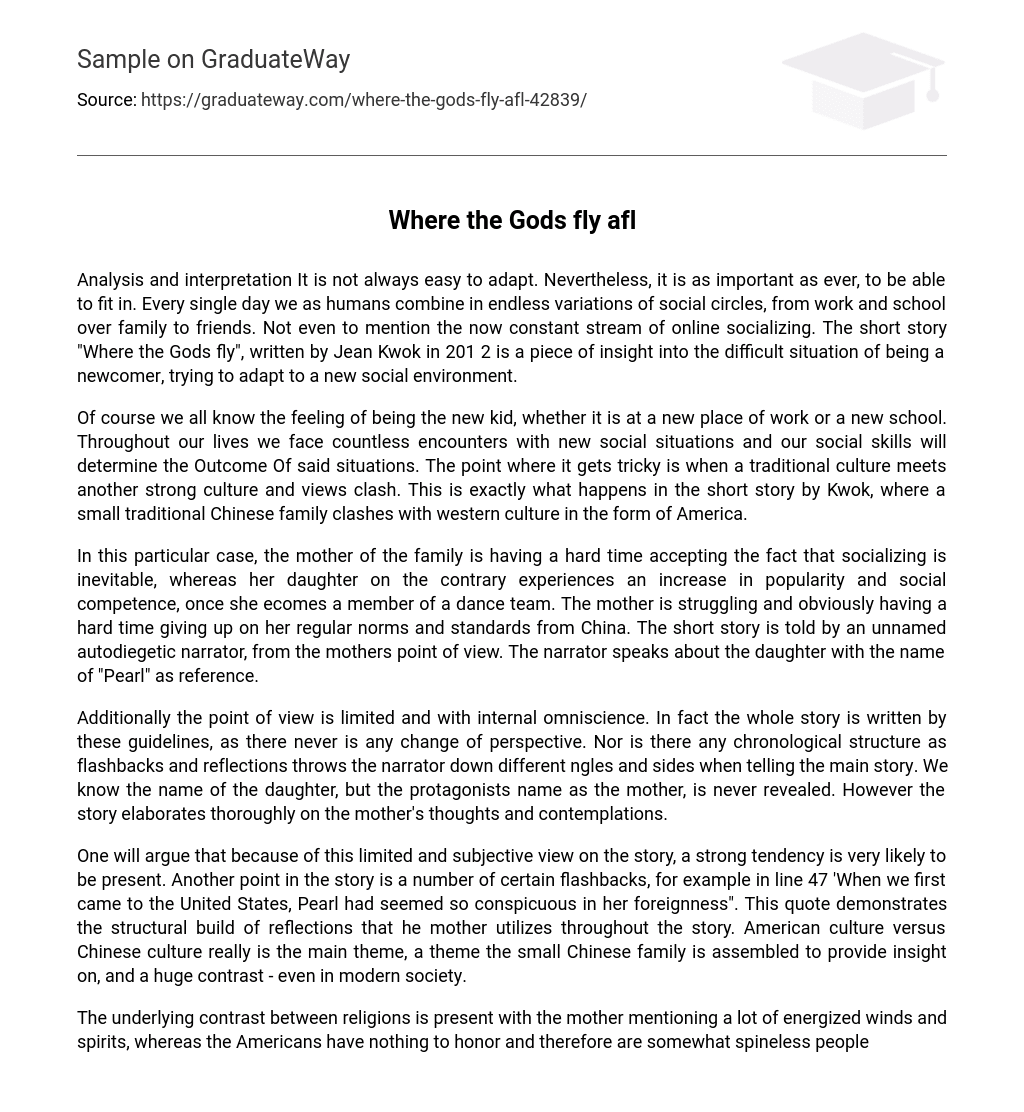Analysis and interpretation It is not always easy to adapt. Nevertheless, it is as important as ever, to be able to fit in. Every single day we as humans combine in endless variations of social circles, from work and school over family to friends. Not even to mention the now constant stream of online socializing. The short story “Where the Gods fly”, written by Jean Kwok in 201 2 is a piece of insight into the difficult situation of being a newcomer, trying to adapt to a new social environment.
Of course we all know the feeling of being the new kid, whether it is at a new place of work or a new school. Throughout our lives we face countless encounters with new social situations and our social skills will determine the Outcome Of said situations. The point where it gets tricky is when a traditional culture meets another strong culture and views clash. This is exactly what happens in the short story by Kwok, where a small traditional Chinese family clashes with western culture in the form of America.
In this particular case, the mother of the family is having a hard time accepting the fact that socializing is inevitable, whereas her daughter on the contrary experiences an increase in popularity and social competence, once she ecomes a member of a dance team. The mother is struggling and obviously having a hard time giving up on her regular norms and standards from China. The short story is told by an unnamed autodiegetic narrator, from the mothers point of view. The narrator speaks about the daughter with the name of “Pearl” as reference.
Additionally the point of view is limited and with internal omniscience. In fact the whole story is written by these guidelines, as there never is any change of perspective. Nor is there any chronological structure as flashbacks and reflections throws the narrator down different ngles and sides when telling the main story. We know the name of the daughter, but the protagonists name as the mother, is never revealed. However the story elaborates thoroughly on the mother’s thoughts and contemplations.
One will argue that because of this limited and subjective view on the story, a strong tendency is very likely to be present. Another point in the story is a number of certain flashbacks, for example in line 47 ‘When we first came to the United States, Pearl had seemed so conspicuous in her foreignness”. This quote demonstrates the structural build of reflections that he mother utilizes throughout the story. American culture versus Chinese culture really is the main theme, a theme the small Chinese family is assembled to provide insight on, and a huge contrast – even in modern society.
The underlying contrast between religions is present with the mother mentioning a lot of energized winds and spirits, whereas the Americans have nothing to honor and therefore are somewhat spineless people with no self- respect. A third count of contrast is the social class differences. Pearl goes to a ballet class which is commonly a very fine-cultural interest, whereas her arents work at a factory and make a modest living “how could I serve tea with coconut slivers and surgared lotus roots in our stained apartment? (line 39-40). The compelling account of the mother feeling her daughter slipping through her hands and falling into the vast void of American naivety provides readers with a previously unseen insight and extremely useful information on the subject of contrast between Chinese traditionalists and American modernists. The whole discussion about how to integrate people to the society comes to a stall when the people who are to be integrated, straight up efuses to take part in any kind of assimilation.
The mother has no regard for the American way whatsoever “l understood nothing of these people who did not bow to our gods and ate with sharp knives at the table” (line 37-39), a passage that shows the mother’s lack of willingness to adapt, and because she does not understand the culture she comprehensibly tries to protect her daughter from a seemingly illusory threat. The source of the mother’s inability to adapt is her lack of education “When was a girl in China, I was not permitted to go to classes” (line 77), a reasonable explanation for her issue ith accepting the new norms in America. Simply put, she does not know any better.
The interesting thing is that the father and especially the mother are so involved with the ancient Chinese doings and sayings, that they cannot open up to new input, while the young Pearl is more than capable of integrating herself. Pearl is not as caught up in strict norms and rituals despite of her upbringing and therefore it is easier for her to enter the American society. The debate that Jean Kwok raises is about trying to find a balance between new and old. It is of the utmost importance to keep in touch with ones roots nd base, while still being able to fit in as a hand in a glove in a globalized world.
The differences amid cultures may seem smaller than ever but character and dignity is hard to keep when succeeding in our world. The boundaries are narrower and steeper than before and the most important thing is not to lose oneself in the process of being human. In conclusion Where the Gods fly creates food for thought by comparing contrasts and thereby highlighting the difficulties of timing and executing integration today. This is an ingenious way of putting thoughts in people’s minds and Jean Kwok does just that. Leave your mark.





